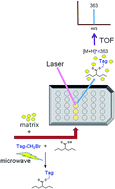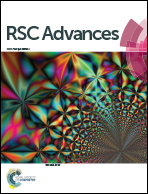Valproic acid analysis by mass spectrometry part I: enhanced determination of valproic acid by microwave assisted chemical labeling†
Abstract
Valproic acid (VA) is the drug of choice for managing epilepsy syndrome and is an effective treatment for various seizures. In recent years, new applications of VA have been developed for clinical treatment of other diseases. In the degradation pathway, cytochrome P450 participates in the biotransformation of VA to other metabolites. The resulting compounds then contribute to apoptosis induced by oxidative stress. Hence, clinical applications of VA medication should be selected carefully to avoid potentially severe side effects such as hepatotoxicity, hypersensitivity syndrome reactions, neurological toxicity and teratogenicity. This work established a simple method of using a microwave assisted derivatization procedure for improved detection and monitoring of VA derivatives by matrix-assisted laser desorption ionization time-of-flight mass spectrometry (MALDI-TOF MS). The calibration curve was 1–100 μM for VA analysis, and good linearity was obtained. In intra- and inter-day analyses, all relative standard deviation (RSD) and relative error (RE) values were below 7.5%.


 Please wait while we load your content...
Please wait while we load your content...